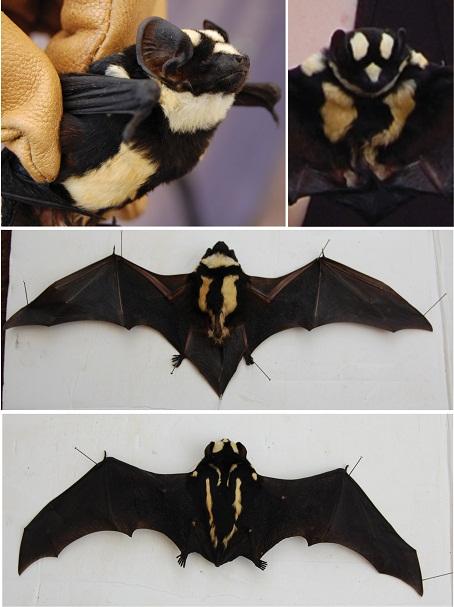As reported a few days ago, scientists in South Sudan have discovered an entirely new bat, so-called a “panda bat” because of the unusual black and white markings. Such a discovery was so rare that the bat was determined to be in an entirely new genus (a step up from species). Researchers from Bucknell University in Pennsylvania, the Smithsonian Institution and the Islamic University in Uganda showcased the bat, Niumbaha superba, in the journal Zookeys. Niumbaha means ‘rare’ or ‘unusual’ in Zande, the language of the Azande people in Western Equatoria State, where the bat was captured. Bucknell Associate Professor of Biology DeeAnn Reeder, who made the discovery, said it was the “find of a lifetime.”
Unfortunately, instead of documenting the discovery with photographs and releasing the bat back into the wild, the rare creature was killed and is being kept as a specimen in the Smithsonian. And according to bat conservationists, the news about how the bat was ultimately handled and killed was covered up.
The researchers contend that their procedures and practices conform to the guidelines of the American Veterinary Medical Association, American Society of Mammalogists, and the Internal Animal Care and Use Committee (IACUC) at Bucknell University. However, such guidelines provide rudimentary and minimal standards that promote the view that the ends justify the means, and violations of those standards brings almost no enforcement. Answering to charges of mishandling the bat, scientists argue “The way the bat is being handled does not hurt the bat. Holding back the wings prevents the bat from hurting itself while being held. This is a standard (and temporary) way to hold a bat for things like photos and/or to study certain characteristics of bats.”
However, according to the Bat World Sanctuary, “Researchers scruff bats to get photographs and to avoid being bitten. It has nothing whatsoever to do with the safety of the bat. Any bat care professional can tell you that when bats are held in a manner that is *comfortable* to them, they rarely attempt to bite and photos are easily obtained.”
The Smithsonian is the same institution that captured and allowed 40 critically endangered Virginia big-eared bats to slowly die over a period of months because they would not use standard husbandry protocols for bats or listen to advice that could have saved the bats.
It is also noteworthy that in the published paper announcing the new bat genus, despite the meticulous measurements made and of the comparisons to other bat genera, the gender was not disclosed. One can reasonably presume a 50% chance the bat was female, immediately raising concerns that with a genus of bat so rare–such that sightings are indeed once in a lifetime–the killing of this bat means she can’t reproduce and the risk of extinction is even higher.
Obtaining knowledge about the world we are inhabiting should include the knowledge about affording the respect all animals deserve. We don’t have to kill living beings to learn about them.
Conservation efforts being made by Bat World Sanctuary, Bat Conservation International as well as other groups to save and protect bats. Please support their work, share this post, and speak out against cruelty and killing of all wildlife.
